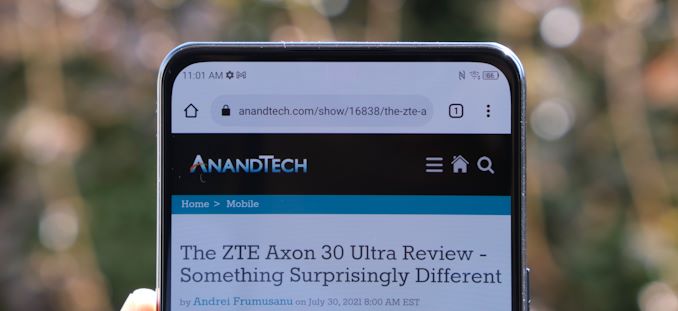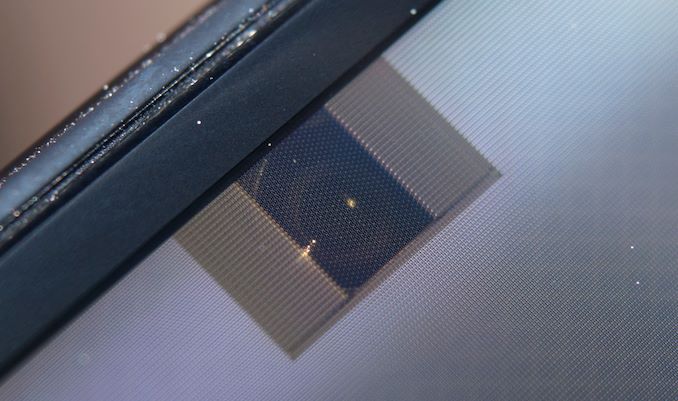The Axon 30 with Under Display Camera: Hands-on Mini-Review
by Andrei Frumusanu on September 3, 2021 9:00 AM EST- Posted in
- Mobile
- Smartphones
- ZTE
- Axon 30
Conclusion & End Remarks
The Axon 30 is an interesting device, both in terms of specifications and also in terms of product category. First and foremost, I had to keep reminding myself that this is a $499 phone, and that’s also a quite important aspect of the device for US readers who usually have extremely little options in that price segment.
Design wise, it’s a relatively generic phone that’s more defined by its size than anything else; with a 6.92” display and 77.8mm body with, it’s a large footprint phone even though it manages to keep things quite reasonable at 189g. Build quality is decent but generally below that of the smaller, higher-end Axon 30 Ultra – which is actually not much of a surprise.
Performance of the phone is great, thanks to the still very competent Snapdragon 870 chip. Peak performance isn’t at S888 levels, however this chip is more power efficient and manages to keep the device cooler than the Axon 30 Ultra.
The defining characteristic of the device is the under-display camera and the screen by Visionox which enables it. There are two large conclusions to be made here:
Firstly, the visual implementation of the UDC is amongst the best we’ve seen so far. While not perfect, the phone manages to hide its under-display camera extremely well. If ZTE manages to even out the brightness differences between the UDC area and the regular panel when viewing the phone head-on, I would say that essentially, you’d be hard pressed to see it anymore.
From a camera quality perspective, I had low expectations, but I was actually still surprised at what ZTE managed to achieve thanks to software processing. Essentially, the camera acts as a 4MP unit, which is quite low res, so you should not really expect great details. Dynamic range and textures are also quite below the norm, however compared to the raw output of the camera, you can’t help but respect the image processing that the phone is achieving.
Overall, if you’re the kind that looks to hide away the front camera to achieve the bezel-less look, I think the Axon 30 is a success. If you still value camera quality – we’re not quite there yet.
The second conclusion of the UDC is related to the display panel itself. It’s the first time we’ve tested a Visionox panel, so I wasn’t sure what to expect, but I had rather low expectations. In terms of brightness, the panel is extremely competitive, however that’s about it when it comes to the positives. The panel differs quite a lot from the usual OLED contenders – when looking at it from extreme angles you can see the polariser shimmering in viridescent colours, something I haven’t seen in many years. The pixel layout, while not exactly visible to the eye, also does feel somewhat less sharp than the regular diamond pentile we’ve gotten used to from Samsung.
One could live with the aforementioned aspects; however, the large deal-breaker is the unsatisfactory power efficiency of the panel. At 423nits brightness, the phone uses 2.87W of power, which is significantly worse than Samsung Display OLED panels (S20U – 2.4W, S21U, 1.8W) Much like the many phones that got ruined by inefficient displays in the past, it also looks like the Axon 30 is also suffering from a larger battery life hit due to the display.
Given the choice of a UDC with an inefficient screen, or a hole-punch with an efficient screen, I’d always choose the latter.
Overall, I think the Axon 30 is an interesting phone, but I can’t help feel it’s still more of an immature technology showcase rather than a refined product. I think the Ultra sibling is still a much better phone, but at least ZTE is pricing the Axon 30 at a quite reasonable level.












24 Comments
View All Comments
Spunjji - Monday, September 6, 2021 - link
I honestly think the compromise in picture quality from the UDC substantially outweighs the tiny functional - and questionable aesthetic - benefits of it being there in the first place. But then I'm one of those weirdos who things having a border at the top and bottom of the screen for speakers and a camera is an asset, not a flaw, and I've been outvoted by the masses. All hail the impending victory of our crappy unsharp-mask-reliant overlords! 😅Kangal - Tuesday, September 7, 2021 - link
Even funnier, you have the opposite thing when you look at the ASUS Zenfone 6/7 Pro/8 Flip.Here, you get to have the sharpest Selfie cam, and a bit of a bulge. But I like it.
I prefer the middle-ground set by the modern Sony 5.2, or the ASUS RoG 5. Other honourable mentions are the Pixel 2XL, ZTE Axon 7, Alcatel Idol 4s, Moto X Style.
Rant:
-I hate these notches and cut-outs. It's functionally bad, and an eyesore.
-And even worse are the curved screens. Why would I want to get content cut out weirdly, have the light glare back on my eyes, increase my accidental taps, and make the device fragile? Form and function should go hand in hand.
-Not to mention the weird 19:9 aspect ratio. They should stick to 16:9 for best compact, or even 17:9 is alright... anything else is just wasteful. At least Sony's 21:9 serves a purpose: very niche people who watch Ultrawide content like Hollywood Movies (not youtube) on their phone.
Tams80 - Tuesday, September 7, 2021 - link
I don't think we've been outvoted by the masses for support of bezels, but rather that most don't care if they are or aren't there (unless they are big) and just follow whatever is trendy.I'd settle for an under-display camera in the middle of the display. I'd still like at least one decent one in a bezel too though.
But hey, this AnandTech. Remember the spats over user-replaceable batteries and SD cards?
nandnandnand - Monday, September 6, 2021 - link
The phone on the phone should have been showing a phone showing a phone showing a phone...